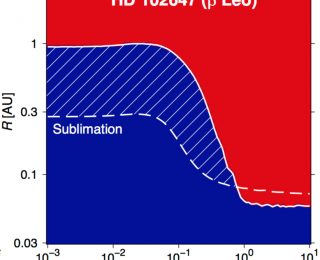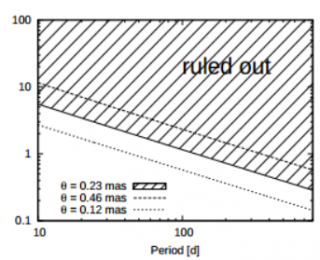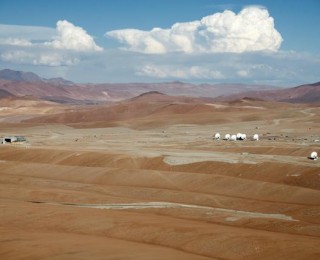
by Eckhart Spalding | Mar 4, 2017 | Daily Paper Summaries
Today we try to get a sense of what near-in and hot dust disks are like around other stars. Aside from being interesting in its own right, the nature of ‘exozodis’ will offer more clarity for planning exoplanet direct-imaging missions.

by Michael Zevin | May 21, 2016 | Daily Paper Summaries
Now that gravitational waves have been directly detected, we can begin to use binary black hole mergers to probe strange consequences of strong-field general relativity. Today’s post examines the prospect of detecting an effect called gravitational-wave memory, and considers its potential for helping you get in shape for summer.

by Ben Montet | Jul 26, 2013 | Daily Paper Summaries
Forbich, Berger, and Reid attempt to use a large radio array to detect stellar wobbles induced by orbiting planets at larger separations than are usually probed

by Erika Nesvold | Jun 27, 2013 | Daily Paper Summaries
The mass of a substellar companion can help determine whether it’s a planet or a brown dwarf. But how can you measure the mass of a companion that you can’t detect directly? Look at the disk!

by Adele Plunkett | May 11, 2012 | Personal Experiences
During the three months that I worked as a visitor in the “Commissioning and Science Verification” group at ALMA, I had the opportunity to spend four week-long “turnos” (shifts) in northern Chile at the ALMA Operations Support Facility (OSF), where the antennas are operated. If you’re interested to learn more about ALMA, you can check out the webpage, or my two previous posts about my experiences during turnos at ALMA. For some of the early science results from ALMA, check out these astrobites.Scientifically and personally, ALMA is an interesting and inspiring place to work. Making observations and then analyzing data, I worked with a number of people with a variety of positions and expertise. At the end of a recent turno I asked them a few simple questions to get a better idea of what a job at ALMA entails. Below are their responses (to the questions in bold), which represent just one sample of perspectives, but to me are sufficiently interesting and demonstrate the diversity and complexity of this project.1. How long have you worked at ALMA? What is your position/title here?At any given time at the OSF, a team of ALMA staff work together to tackle all aspects of the system. Job titles (for those interviewed here) at ALMA include commissioning scientist, data analyst and system astronomer. ALMA is an international partnership of Europe, North America and East Asia in cooperation with the Republic of Chile, so the control room is nearly always staffed with a very diverse group of people from around the world. Many organizations contribute funding and personnel for the project.One of the scientists...
by Adele Plunkett | Mar 4, 2012 | Personal Experiences
Note: This is the second astrobite in a periodic series chronicling my adventures doing astronomy research in Chile (click here to read the first astrobite of the series). For details on ALMA (the Atacama Large Millimeter/submillimeter Array), check out the observatory’s website, and go here for resources with more details on ALMA science and techniques. An Introduction to Millimeter/Sub-millimeter InterferometryAn important feature of a telescope is its resolution, or the degree of detail that it can observe. The resolution depends on the ratio of wavelength of light to diameter of the telescope dish/mirror; in other words, observations will be higher resolution if they are of shorter wavelength light and/or made with a larger diameter telescope. ALMA is sensitive to light with wavelengths that are from about 300 micrometers to 3 millimeters (approximately 0.0003 to 0.003 meters). This is called millimeter and submillimeter radiation, and it falls at the short wavelength (high frequency) end of the radio spectrum. For comparison, visible light has wavelengths about 1000 times shorter, between roughly 380 and 750 nanometers (0.00000038 to 0.00000075 meters). This balance of wavelength and telescope diameter results in the interesting fact that a single 7- or 12-m ALMA antenna “sees” only slightly more detail than your eye can see in visible wavelengths.The science goals of ALMA require very high resolution. (A quick note: resolution is measured as an angle, and in this post I will use units of arcseconds. Remember, 1 degree equals 3600 arcseconds, and for reference, the apparent size of the moon is about 0.5 degrees, or 1800 arcseconds.) Given the wavelength constraints, the best way to achieve high...





